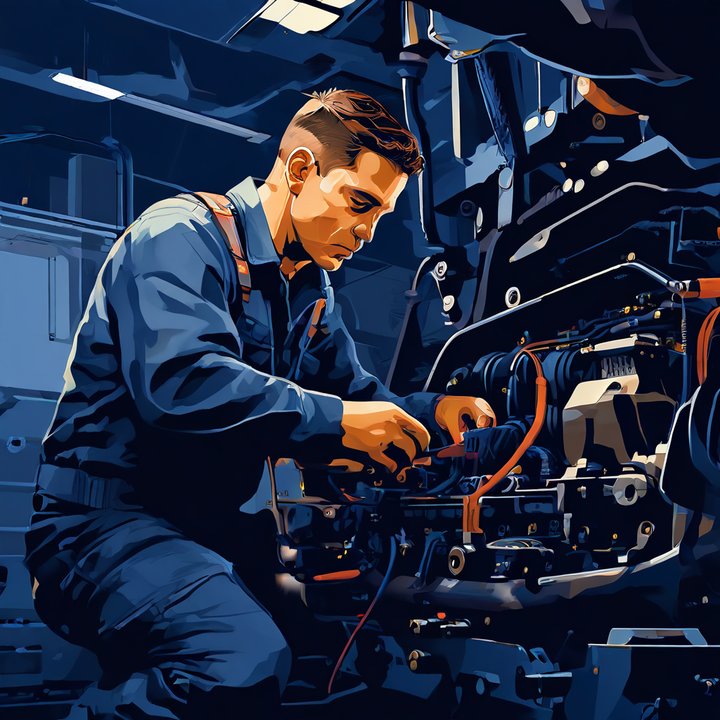


The P03F2 code indicates a problem with the "B" camshaft profile actuator control circuit on Bank 1. Specifically, it suggests that the control circuit is experiencing a low electrical condition. This code is specific to certain vehicle manufacturers and may not be universally applicable across all makes and models.
Before we delve into the nitty-gritty of the P03F2 code, let's first understand the role of the camshaft profile actuator. This crucial component is responsible for adjusting the camshaft timing, which plays a vital role in optimizing engine performance and efficiency. By precisely controlling the timing of the valves' opening and closing, the camshaft profile actuator ensures that the engine runs smoothly and efficiently, delivering the power and fuel economy you expect.
| Component | Function |
|---|---|
| Camshaft Profile Actuator | Adjusts camshaft timing for optimal engine performance and efficiency |
| Camshaft Position Sensor | Provides feedback to the ECM about the camshaft's position |
| Variable Valve Timing (VVT) Solenoid | Works with the actuator to adjust valve timing |
Now, let's tackle the code itself. The P03F2 - "B" Camshaft Profile Actuator C Control Circuit Low Bank 1 is a diagnostic trouble code that indicates a low voltage condition in the control circuit of the camshaft profile actuator on the engine's bank 1 (typically the side with cylinder 1). This low voltage can prevent the actuator from functioning correctly, leading to a host of potential issues.
Like any good detective, we need to investigate the potential suspects behind this code. Here are some of the most common causes:
Faulty Camshaft Position Sensor
Damaged Wiring or Connectors
Clogged or Stuck Camshaft Profile Actuator
Issues with the Engine Control Module (ECM) or Powertrain Control Module (PCM)
Malfunctioning Variable Valve Timing (VVT) Solenoid
The camshaft position sensor plays a crucial role in providing feedback to the engine control module (ECM) about the camshaft's position. If this sensor is malfunctioning, it can trigger the P03F2 code. Symptoms of a faulty camshaft position sensor may include:
Engine misfiring
Rough idling
Poor fuel economy
Check engine light illuminated
Wiring issues are often the bane of any mechanic's existence. Loose, damaged, or corroded wiring and connectors in the camshaft profile actuator circuit can disrupt the flow of information and power, leading to the dreaded P03F2. Potential causes of wiring issues include:
Exposure to heat, moisture, or vibration
Rodent damage
Improper installation or repair
Over time, contaminants or debris can find their way into the camshaft profile actuator, causing it to stick or become clogged. This can prevent the actuator from functioning correctly and trigger the code. Common causes of a clogged or stuck actuator include:
Contaminated engine oil
Sludge buildup
Debris from engine wear
The engine control module (ECM) or powertrain control module (PCM) is the brain of the engine management system. If there are any software glitches or hardware issues with these components, it can lead to various trouble codes, including the P03F2. Potential issues with the ECM or PCM may include:
Software bugs or glitches
Electrical faults or damage
Compatibility issues with aftermarket parts
The variable valve timing (VVT) solenoid works in tandem with the camshaft profile actuator to adjust the valve timing. If this solenoid is faulty, it can cause issues with the actuator and trigger the P03F2 code. Symptoms of a malfunctioning VVT solenoid may include:
Rough idling
Poor engine performance
Increased fuel consumption
Now that we know the potential suspects, it's time to roll up our sleeves and start the investigation. Here are the steps I typically follow when troubleshooting the P03F2 code:
Inspect the Wiring and Connectors
Check for any loose, damaged, or corroded wiring and connectors related to the camshaft profile actuator circuit.
Repair or replace any faulty wiring or connectors.
Check the Camshaft Position Sensor
Inspect the camshaft position sensor for proper operation.
Replace the sensor if it's faulty.
Evaluate the Engine Oil
Check the engine oil level and condition.
Perform an oil change if the oil is contaminated or low.
Inspect the Camshaft Profile Actuator
Conduct a visual inspection of the camshaft profile actuator for any signs of damage or sticking.
Clean or replace the actuator if necessary.
Scan for Related Trouble Codes
Use a diagnostic scan tool to check for any related trouble codes.
Monitor the camshaft position sensor data for any irregularities.
Test the VVT Solenoid
Test the variable valve timing (VVT) solenoid for proper operation.
Replace the solenoid if it's defective.
Once we've identified the culprit, it's time to roll up our sleeves and get to work. Here are the typical repair instructions for the P03F2 code:
| Repair | Instructions |
|---|---|
| Replace Damaged Wiring or Connectors | Repair or replace any damaged wiring or connectors in the camshaft profile actuator circuit. |
| Clean or Replace the Camshaft Profile Actuator | If the actuator is stuck or clogged, clean it or replace it entirely. |
| Replace the Camshaft Position Sensor | Replace the camshaft position sensor with a new one if it's faulty. |
| Update or Reprogram the ECM/PCM | Update or reprogram the ECM/PCM software with the latest available updates related to this issue. |
| Replace the VVT Solenoid | Replace the variable valve timing (VVT) solenoid with a new one if it's malfunctioning. |
As the saying goes, "an ounce of prevention is worth a pound of cure." To help prevent the P03F2 code from rearing its ugly head, here are some preventive measures I recommend:
Follow Recommended Oil Change Intervals
Use the correct engine oil type and viscosity.
Change the oil at the recommended intervals to prevent contamination and ensure proper lubrication.
Inspect and Replace Worn Timing Components
During scheduled maintenance, inspect and replace any worn or damaged timing components, such as the timing chain or belt.
Avoid Excessive Heat and Contaminants
Exposing the engine to excessive heat or contaminants can damage the actuator or sensors.
Avoid these conditions whenever possible.
Use High-Quality Fuel
Use high-quality fuel and avoid fuel additives that may contaminate the system.
Contaminated fuel can lead to issues with the camshaft profile actuator and other engine components.
Now, let's address the elephant in the room: the cost of repairs. The cost can vary depending on the specific cause and the make and model of your vehicle, but here are some approximate costs for common repairs:
| Repair | Approximate Cost |
|---|---|
| Camshaft Position Sensor Replacement | $100 - $300 |
| Wiring or Connector Repair/Replacement | $100 - $300 |
| Camshaft Profile Actuator Replacement | $300 - $800 |
| Variable Valve Timing (VVT) Solenoid Replacement | $200 - $500 |
| ECM/PCM Reprogramming | $300 - $500 |
| ECM/PCM Replacement | $500 - $1,000 |
It's important to note that these costs are estimates and may vary based on your location, the specific vehicle, and the labor rates of the repair shop. Additionally, some repairs may require additional parts or labor, which can increase the overall cost.
Phew, that was quite a journey! We've covered the ins and outs of the P03F2 - "B" Camshaft Profile Actuator C Control Circuit Low Bank 1 code, from its causes and troubleshooting steps to repair instructions and preventive measures. While this code may seem daunting at first, with the right knowledge and approach, it's a challenge that can be overcome.
Remember, regular maintenance and attention to your vehicle's needs can go a long way in preventing issues like the P03F2 code from occurring in the first place. And if you ever find yourself facing this code, don't hesitate to seek the expertise of a qualified mechanic.
Happy motoring, my friends! May your camshaft profile actuators always be in tip-top shape, and may your diagnostic trouble codes be few and far between.
The camshaft profile actuator adjusts the camshaft timing to optimize engine performance and efficiency. It controls the opening and closing of the valves for precise combustion.
A faulty camshaft position sensor can cause engine misfiring, rough idling, poor fuel economy, and illuminate the check engine light.
Signs include decreased engine performance, increased fuel consumption, and potential illumination of the check engine light.
Yes, software bugs or glitches in the engine control module (ECM) or powertrain control module (PCM) can lead to various trouble codes, including P03F2.
The VVT solenoid works together with the camshaft profile actuator to adjust the valve timing based on engine operating conditions.
Inspect the wiring and connectors in the camshaft profile actuator circuit for any loose, damaged, or corroded components, and repair or replace as needed.
Contaminated or low engine oil can cause the camshaft profile actuator to stick or malfunction, potentially leading to the P03F2 code.
Use a scan tool to check for related trouble codes, monitor the camshaft position sensor data, and test the variable valve timing (VVT) solenoid.
Yes, updating or reprogramming the ECM/PCM software with the latest available updates related to this issue can potentially resolve the P03F2 code.
Follow recommended oil change intervals, inspect and replace worn timing components, avoid excessive heat and contaminants, and use high-quality fuel.

Miguel started tinkering with car radios as a teenager, fascinated by the intricate dance of wires and circuits. This passion led him to pursue a career as an automotive electrician. For the past 10 years, Miguel has tackled everything from flickering headlights to mysterious electrical gremlins. He thrives on troubleshooting electrical problems and enjoys sharing his knowledge to empower car owners to understand their vehicles better.



